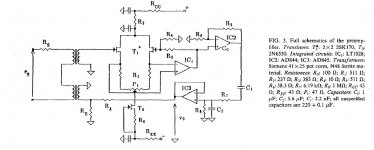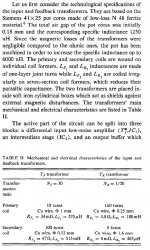Just a sarcastic note.... why hasn't anyone replaced Doug's op amp choice with the highly aclaimed Burson op amp as seen in some threads on the forum. Obviously this would solve all the shortcomings in the design.
Nice web-site Bonsai
Thanks Nico.
Not in audio, it is not a match terminated system. A 10 Ohm MC has .4 nV of noise, a JFET preamp could be concocted with .2nV voltage noise and virtually no current noise. No power is delivered to the JFET since the input impedance is >>10 Ohms.
Which begs another question, the synthesized 47K still looks like 47K to the current noise of the op-amp.
Hi Scott,
As you know, the synthesized cartridge loading resistance is an old idea. I did it 30+years ago on the last phono preamp I built before CDs took over, and I'm sure many did it before me. In my case, I started off with a flat gain = +10 input amplifier, then inverted the signal and fed it back through an 11 X 47k resistor to get the 47k. It worked reasonably well, but of course it does nothing for the noise caused by the input current noise of the first stage.
In Doug's design, he hangs both a 5534 and a 5532 off of the input node for the first stage gain and the load synthesis, respectively. It seems that the increased resulting op amp current noise defeats much of the advantage of the synthesis of the load, to the point where the whole thing is probably not worth it. Synthesizing the load when one uses a low-noise JFET input amplifier probably makes more sense, but even then the advantage may be marginal, since the synthesis technique predominantly reduces the noise only at the higher frequencies where the impedance of the cartridge gets high enough to make a difference.
Finally, the "color" of noise matters in determining how objectionable it is for a given RIAA-equalized, A-weighted S/N. The "color" of noise, of course, refers to its spectral shape. We all know what white noise is (0 dB/octave decline with frequency) and what pink noise is (-3dB/octave). There is also "Red" noise, whose spectral density falls off at 6 dB/octave. This is also sometimes called "Brown" noise, after the statistics of Brownian motion which it shares some similarity with. There have also been other colors of noise defined, like Green and Blue, but I don't remember the details. I think their densities go up with frequency, perhaps at 3 and 6 dB per octave, respectively, but I'm not sure. Anyway, for the same A-weighted S/N, the noise power is distributed differently for these different colors of noise and the result sounds different. Noise whose spectrum is weighted toward the high frequencies tends to be less objectionable. I suppose one could also use the term "noise temperature" to describe it in a way analogous to the video world. RIAA equalization tends to redden the noise from a phono preamp. Different phono preamp architectures can produce different noise "color" depending on where the dominant noise source is in the signal chain and whether there is a frequency response at work at that injection node. Based on this, the noise created by the conventional 47k load resistor may not be very objectionable. Note that A weighting mimics the audibility of noise without consideration for how objectionable it is psycho-acoustically. Put another way, a preamp with worse A-weighted S/N, but in which most of the noise power is at the higher frequencies, might not be any more objectionable with respect to how the noise is perceived.
Cheers,
Bob
Scott, show me an active J-Fet stage with .2nV voltage noise and there is 1/F noise under 1kHz. I ran into a concrete wall at .3nV.
That was a hypothetical number .3nV would still do. I could envision the most extreme InterFet parts doing this, but the parts and the design get so narrow and exotic that it is just an academic exercise.
Transformer feedback can get .065nV but needs to be tuned to the cartridge series R at low frequencies.
Transformer feedback can get .065nV but needs to be tuned to the cartridge series R at low frequencies.
Could you show a conceptual schematic? Is it just transforming up the feedback impedance so as not to load down the output as much with a low R feedback resistor or is there more subtlety?
Could you show a conceptual schematic? Is it just transforming up the feedback impedance so as not to load down the output as much with a low R feedback resistor or is there more subtlety?
Rev. Sci. Inst. Vol 63 No 3 1992
I don't know how to tune this thing, as presented more that 1 Ohm real part of input Z had problems at the low end. Those are hand wound pot cores at the input.
Attachments
Hi Scott,
Put another way, a preamp with worse A-weighted S/N, but in which most of the noise power is at the higher frequencies, might not be any more objectionable with respect to how the noise is perceived.
Cheers,
Bob
Good points Bob, in the microphone biz there is a lot of controversy around noise spectra. Related to this, B&K chose to go the route of custom eqalization for an ultra-low noise mic and reduced the acoustical damping "resistor" dramatically. I think that was the gist of a Linear Audio article last issue, the down side is the need to match your preamp to each cart.
Many thanks. Know the turns ratios offhand? If not, I can probably dig up the original paper.
Attachments
True, with transformer you can get down to the Johnson noise of the input winding.
The best ones go down to 0.5 Ohm so putting a 5 Ohm cartridge on the input makes the S/N 20dB worse !
I build a stage with the Sowter transformer ( 0.75 Ohm primary ) that i fed back differentially into an OPA1632 where i got an extremely low and straight baseline at
-160dBV ( referenced to 1V ). I could extend the frequency response to 360kHz, the zero in my passive Anti RIIA so the high frequency limit of the transformer was more or less eroded. Another problem is the saturation distortion in the bass of the transformer and i do admit that i did not measure that. I published the measurement on the High Resolution Forum. I hope i can find it and publish it here.
The best ones go down to 0.5 Ohm so putting a 5 Ohm cartridge on the input makes the S/N 20dB worse !
I build a stage with the Sowter transformer ( 0.75 Ohm primary ) that i fed back differentially into an OPA1632 where i got an extremely low and straight baseline at
-160dBV ( referenced to 1V ). I could extend the frequency response to 360kHz, the zero in my passive Anti RIIA so the high frequency limit of the transformer was more or less eroded. Another problem is the saturation distortion in the bass of the transformer and i do admit that i did not measure that. I published the measurement on the High Resolution Forum. I hope i can find it and publish it here.
I found the measurements and the commend i did at that time.
The red baseline ( input shouted with a "special" shorting plug ) shows some 1/F.
That comes from the second active stage. I can do a bit better now.
The red baseline ( input shouted with a "special" shorting plug ) shows some 1/F.
That comes from the second active stage. I can do a bit better now.
Attachments
I know where you're coming from, and I'm aware that a short/open system as used in audio does not use power matching as known from RF. Let me illustrate my point:Not in audio, it is not a match terminated system. A 10 Ohm MC has .4 nV of noise, a JFET preamp could be concocted with .2nV voltage noise and virtually no current noise. No power is delivered to the JFET since the input impedance is >>10 Ohms.
If, in a bog standard preamp, you change the volume pot value within certain limits, power transfer to the amplifier with its much higher input impedance does not change either and remains minimal (same situation as outlined above). Yet, a lower-value part gives less voltage noise. The difference? For the same input voltage, available power increased, and quite practically there is more dissipation in the pot.
Likewise, if you want to drive a low-noise amp from a preceding stage, that stage needs to have very low noise, too - which means low-value feedback resistors. Signal power is now dissipated in those. ("Noiseless feedback" using Cs or Ls/xfmrs exists in RF but is not usually sighted in audio, though MC pres with transformer feedback might apply. Haven't looked at these much so far.)
So even if, strictly speaking, signal power is not transferred, it generally has to flow somewhere.
For all you noisy people
Download in OpenDocument format
("Noiseless feedback" using Cs or Ls/xfmrs exists in RF but is not usually sighted in audio, though MC pres with transformer feedback might apply. Haven't looked at these much so far.)
Your countryman Ulrich Rohde championed these, a brilliant man.
Sgr,
what is an ods file?
It's an Open Document Spreadsheet file extension, as used by LibreOffice & OpenOffice packages. (Both are free office suites and are mostly compatible with MS Office file formats).
Hi just found this entertaining thread.
Quote from D Self
With tiresome inevitability, the very popularity and excellent technical performance of the 5532 has led to it being savagely criticised by Subjectivists who have contrived to convince themselves that they can tell opamps apart by listening to music played through them. This always draws a hollow laugh from me, as there is probably no music on the planet that has not passed through a hundred or more 5532s on its way to the consumer.
I CAN hear the differences in opamps playing music.
The OPA827's in my 4396 dac were outstandingly different from the very first note and drumbeat. 5532's were fitted as standard.
AND it doesn't matter how many NE5532's the signal has gone through whilst recording, that is out of our hands, what matters is what it goes through when we get it home.
Quote from D Self
With tiresome inevitability, the very popularity and excellent technical performance of the 5532 has led to it being savagely criticised by Subjectivists who have contrived to convince themselves that they can tell opamps apart by listening to music played through them. This always draws a hollow laugh from me, as there is probably no music on the planet that has not passed through a hundred or more 5532s on its way to the consumer.
I CAN hear the differences in opamps playing music.
The OPA827's in my 4396 dac were outstandingly different from the very first note and drumbeat. 5532's were fitted as standard.
AND it doesn't matter how many NE5532's the signal has gone through whilst recording, that is out of our hands, what matters is what it goes through when we get it home.
Last edited:
Have you read Mooly's Thread?.............I CAN hear the differences in opamps playing music.
The OPA827's in my 4396 dac were outstandingly different from the very first note and drumbeat...............
Are you aware that swapping the opamp is one of the easiest ways to ensure that the opamp will misbehave?
- Home
- Source & Line
- Analog Line Level
- New Doug Self pre-amp design...



